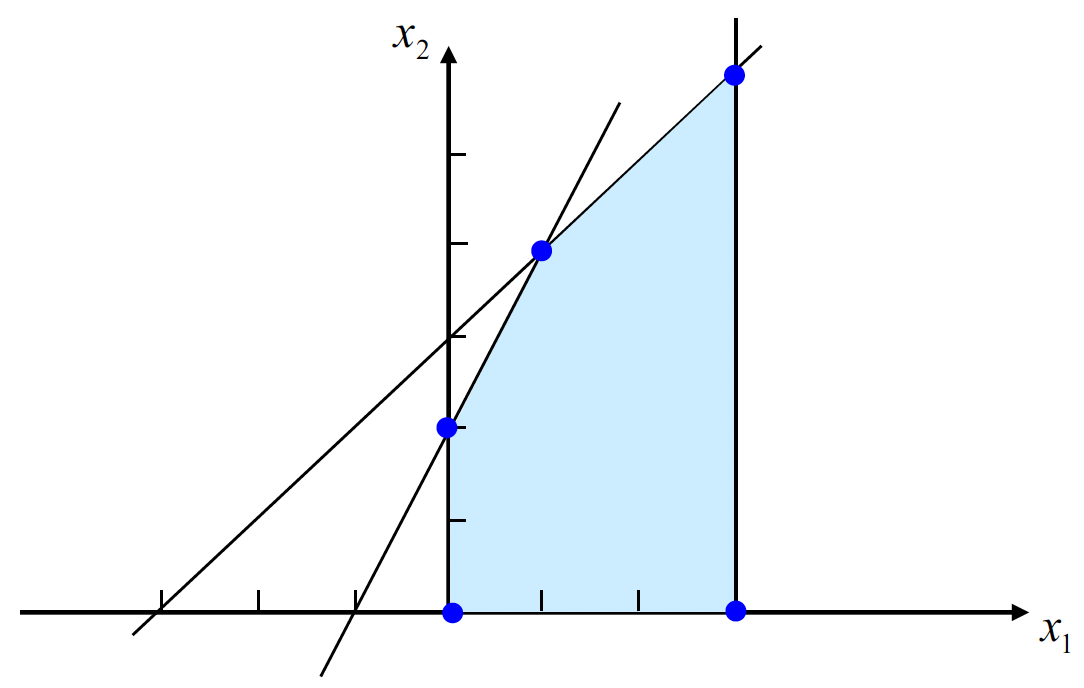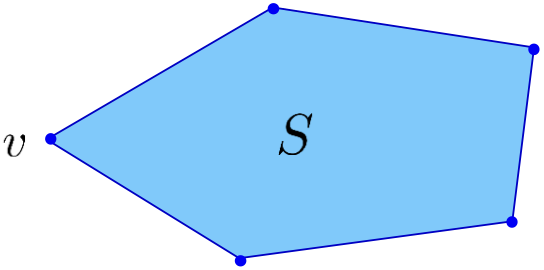12. Geometry of Linear Programming
- -
Introduction
Linear programs can be studied both algebraically and geometrically. The two approaches are equivalent, but one or the other may be more convenient for answering a particular question about a linear program.
The algebraic point of view is based on writing the linear program in a particular way, called standard form. Then the coefficient matrix of the constraints of the linear program can be analyzed using the tools of linear algebra.
The geometric point of view is based on the geometry of the feasible region and uses ideas such as convexity to analyze the linear program. It is less dependent on the particular way in which the constraints are written.
Example
Consider the problem
subject to
The feasible region is graphed like this

As you can see in the above graph, it has a solution at the corner. But it is no coincidence that the solution occurred at a corner or extreme point.
Standard Form
There are many different ways to represent a linear program. It is sometimes more convenient to use one instead of another. It is called standard form, will be used to describe the simplex method.
In a standard form, it can be represented
subject to
Note that every linear programming can be transformed into standard form.
From now on, with out any comment, we will assume that A has full rank.
Note that the full-rank assumption is not unreasonable. If A is not a full rank, then either the constraints are inconsistent or there are redundant constraints.
- If the constraints are inconsistent, then the problem has no solution and the feasible solution is empty.
- If there are redundant constraints, then theoretically they could be removed from the problem without changing either the solution or the feasible region.
Example
What if we have inequality constraints? In that case, we can easily transform into the standard form by using the slack variable.
For instance,
subject to

This optimization problem can be converted into
subject to
Extreme Points
A point of a vertex set is an extreme point (or vertex) if it can not be expressed using a convex combination of other points. That is
where x,y∈S,0<α<1
Then,
In other words, an extreme point is not on the line segment of two different points.

Representation Theorem
Any non-extreme point x can be expressed using a convex combination of extreme points.
Let {v1,v2,…,vk} be the set of extreme points of S.
Since x is not a extreme point, we can express x as
where αi≥0,∑i=1kαi=1
If we transform our original optimization problem into the standard form, our objective function is always like this
That means,
Therefore, every non-extreme point can be expressed by linear combination of the extreme points.
Basic Solutions
A basic solution is defined algebraically using the standard form of the constraints. A point x is a basic solution if
- x satisfies the equality constraints of the linear program
- the columns of the constraint matrix corresponding to the nonzero component of x are linearly independent
The set of basic variables is called the basis
If x≥0, it is called a basic feasible solution (BFS). If is an optimal basic feasible solution if it is also optimal for the linear program.
Example

subject to
Take x3=0
Extreme Point = BFS
A point x is an extreme point of the set {x:Ax=b,x≥0} if and only if it is a basic feasible solution.
Proof
Firstly, we show that if x is a feasible solution, then it is a extreme point. W.L.O.G we may assume that the last n−m variables of x are non-basic (if not, we can do so by switching the order of the column of A). That is
Let B be the invertible basis matrix corresponding to xB. If x is not an extreme point, then there exist two distinct feasible point y and z such that
where y,z∈S,0<α<1
Let
Since y,z are feasible,
Moreover, since B is invertible
However, it contradicts to the assumption. Therefore, x is an extreme point.
Secondly, we prove that if x is an extreme point, then x is a basic feasible point. Let x is a extreme point. That means Ax=b and x≥0. W.L.O.G x can be written as
where xB>0 and xN=0. In addition, we can write
where B and N are the coefficient correspoinding to xB and xN respectively.
If the columns of B are linearly independent, then x is clearly basic solution so that there is nothing to prove.
On the other hand, suppose the columns of B are linearly dependent. Then, there exist p such that
where p is not zero vector.
In addition, since xB is positive, we can always find ϵ>0 such that
Take
Then, y and z are also feasible point. Moreover
But it contradicts to the fact that x is a extreme point.
Therefore, x is a basic feasible solution.
Degenerate Solutions
It is possible that one or more of the basic variables in a basic feasible solution will be zero. If this occurs, then the point is called degenerate vertex, and the linear program is said to be degenerate.
Consider the example, with one additional constraint x2≤6
subject to
If we take non-basic variable as s3 and s4, we can derive s2=0
Additional definitions
Adjacent Extreme Points
Two extreme points are said to be adjacent if they are connected by an edge of the feasible region. This means there is a direct line or edge that connects the two points within the feasible region.
Adjacent Bases
In a linear programming problem, if you have m equality constraints, two bases are considered adjacent if they share m−1 common variables. Essentially, two bases are adjacent if they agree on most variables and differ in just one.
Adjacent Basic Feasible Solutions
In the context of linear programming, basic feasible solutions (BFS) are solutions that satisfy all constraints of the problem and are located at the vertices of the feasible region. Now, two basic feasible solutions are said to be adjacent if they share all but one of their basic variables.
In other words, if you can move from one BFS to another by just changing one variable (while still remaining within the feasible region), then these two solutions are called adjacent basic feasible solutions. This concept is crucial in the simplex method, as the method involves moving from one BFS to another, improving the objective function at each step, until the optimal solution is reached.
BFS and Optimality

If a linear program in standard form has a finite optimal solution, then it has an optimal basic feasible solution
소중한 공감 감사합니다